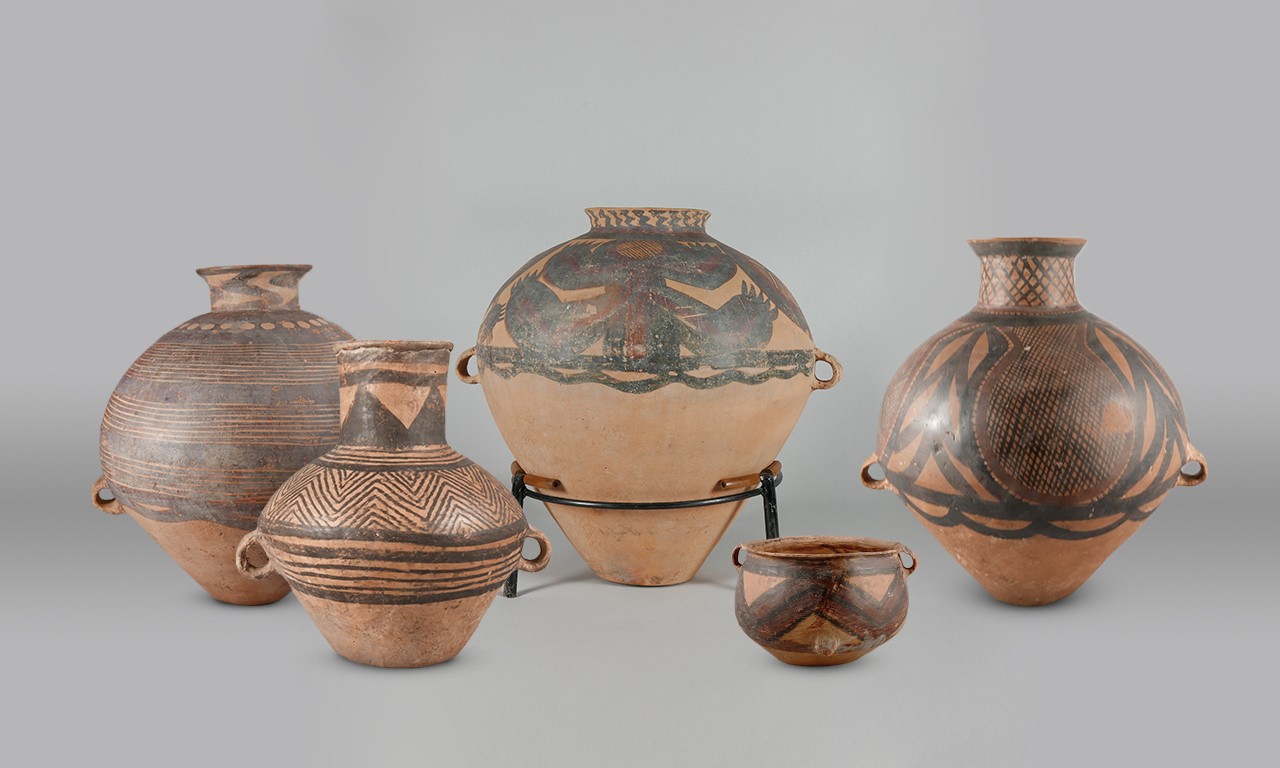 |
Vessels, mid to late Neolithic period (5000-2050 BCE)
Yangshao and Majiayao cultures; China
Painted ceramic
90.5.64, 91.48.5, 97.119.1, 99.54.1, 2000.39.1
Gifts of Patricia de Hoffman, Carroll and Susanne Barrymore, Mr. Lowell C. Martindale, Jr., and Linda Shih |
Yangshao Culture’s Significance
The Yangshao culture, a neolithic Chinese society that lived along the Yellow River in what is today China’s Shaanxi and Henan Provinces between 5000 and 3000 BCE, is best known today for its pottery tradition. Some Chinese archeologists consider the Yangshao culture as the earliest stage of Chinese civilization because of its advancements in ceramics, rather than the traditional Shang or Zhou dynasties which began in the 16th and 11th centuries BCE respectively. The Bowers Museum is fortunate to include in its permanent collection several ceramic vessels from the Yangshao’s painted pottery culture.
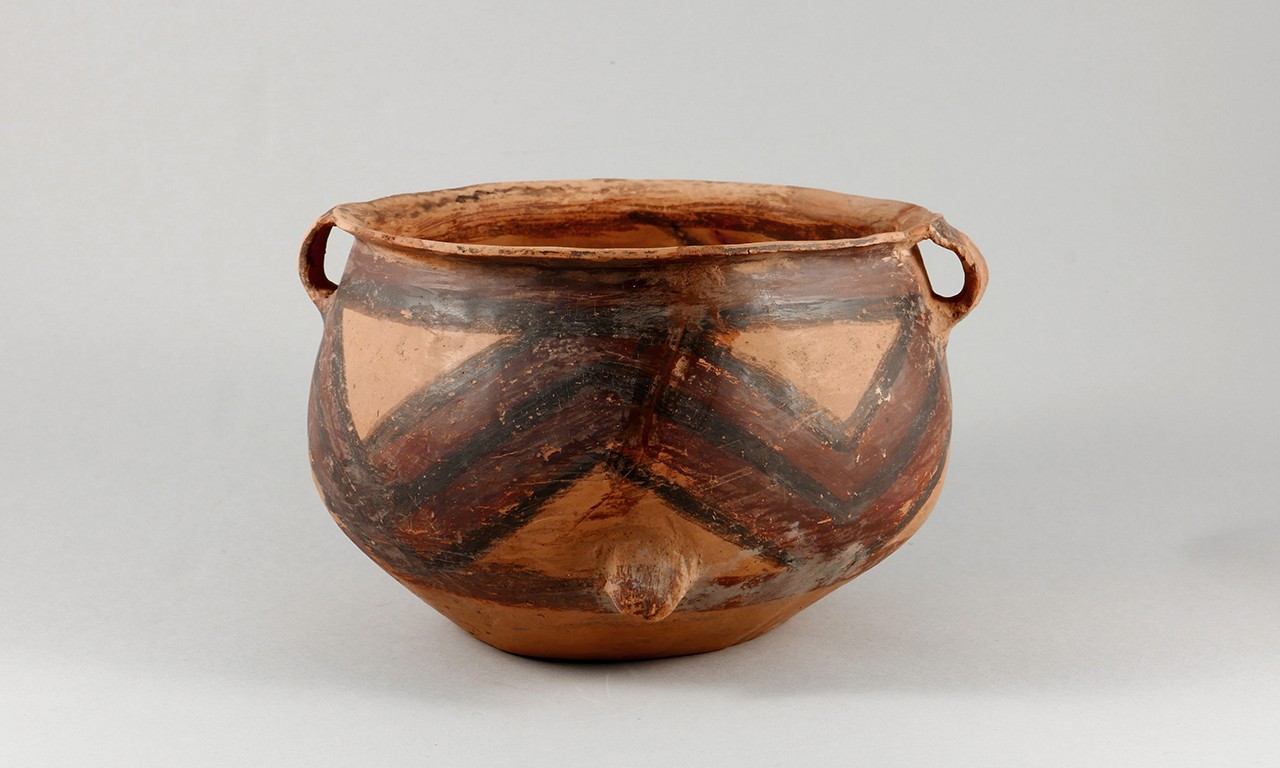 |
Bowl, mid-Neolithic period (4000–2500 BCE)
Yangshao culture; Shaanxi or Henan Province, China
Painted ceramic; 4 1/4 x 6 7/8 in.
90.5.64
Gift of Patricia de Hoffman |
Incredi-Bowl
The above bowl has several attributes characteristic of Yangshao pottery: a burnished tan or orange surface decorated with black, brown, or red geometric patterns. The design zigzags across the surface of the bowl and the handles at the bowl’s sides as well as its depth make it functional for either cooking or eating purposes.
Motifs such as the zigzag pattern have been identified as commonly used motifs in the Neolithic period of Chinese ceramics. Archeologists have identified about 140 of these commonly used symbols. They include human faces, fish, birds, and fangs, among others, and these motifs often reflect a spiritual belief or deity.
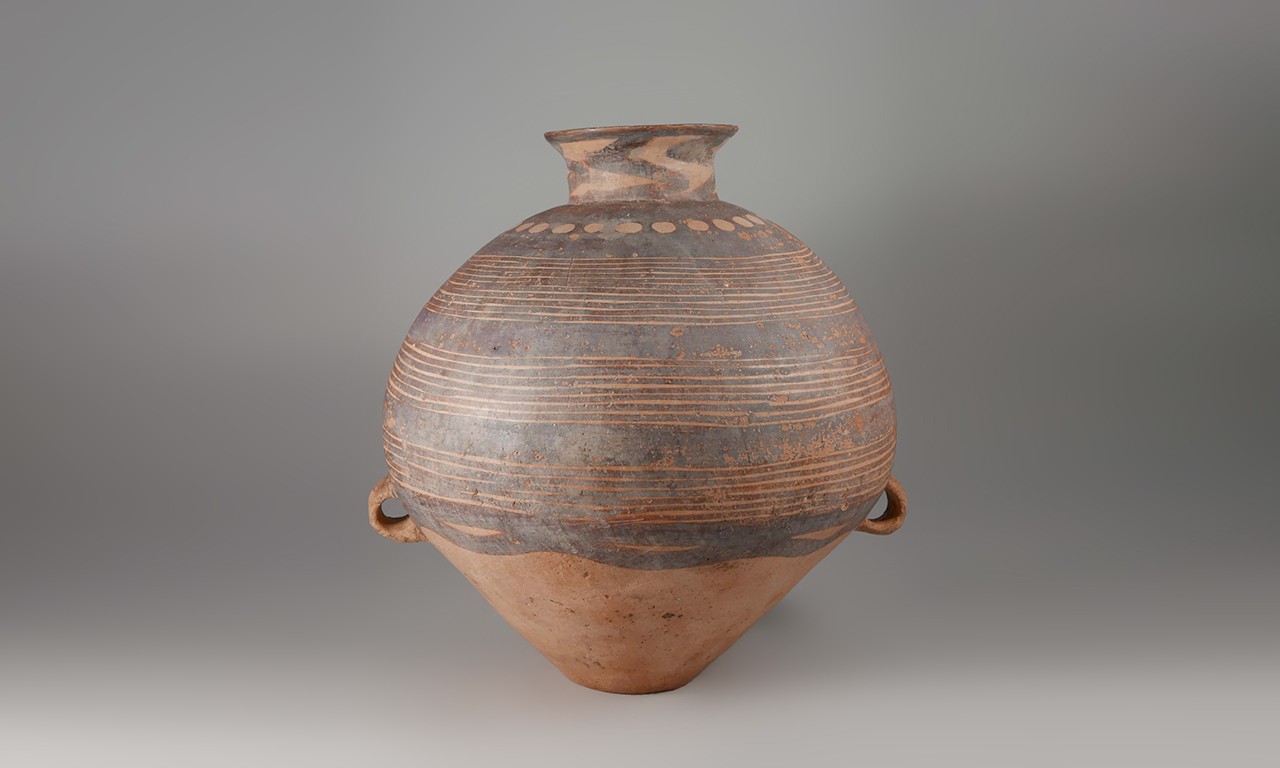 |
Jar, mid-Neolithic period (5000-3000 BCE)
Yangshao culture; Shaanxi or Henan Province, China
Painted ceramic; 13 x 12 x 36 1/4 in.
91.48.5
Gift of Carroll and Susanne Barrymore |
Get a Handle on It
This jar has functional handles like the previous bowl, yet its pattern and shape are rather unique. In Chinese Neolithic pottery, bands of circles inside a vessel’s rim as well as around its neck – as pictured above – are unusual. Additionally, the bulbous form of the jar is quite rare and emphasized in this case by the horizontal line pattern and low handles. The handles were likely made on a spinning wheel.
Jars during this period were constructed by coiling rolled clay that was then smoothed and shaped into a form with hand tools. Afterwards, the detailed line pattern on the jar was applied with a paintbrush. Utilizing a brush here is significant because the use of a brush to apply decorative elements firmly establishes the tradition of brushwork in Chinese art history. The early brushwork tradition lends additional support to the idea that the Yangshao could likely be the beginning of Chinese civilization instead of the Shang or Zhou dynasties.
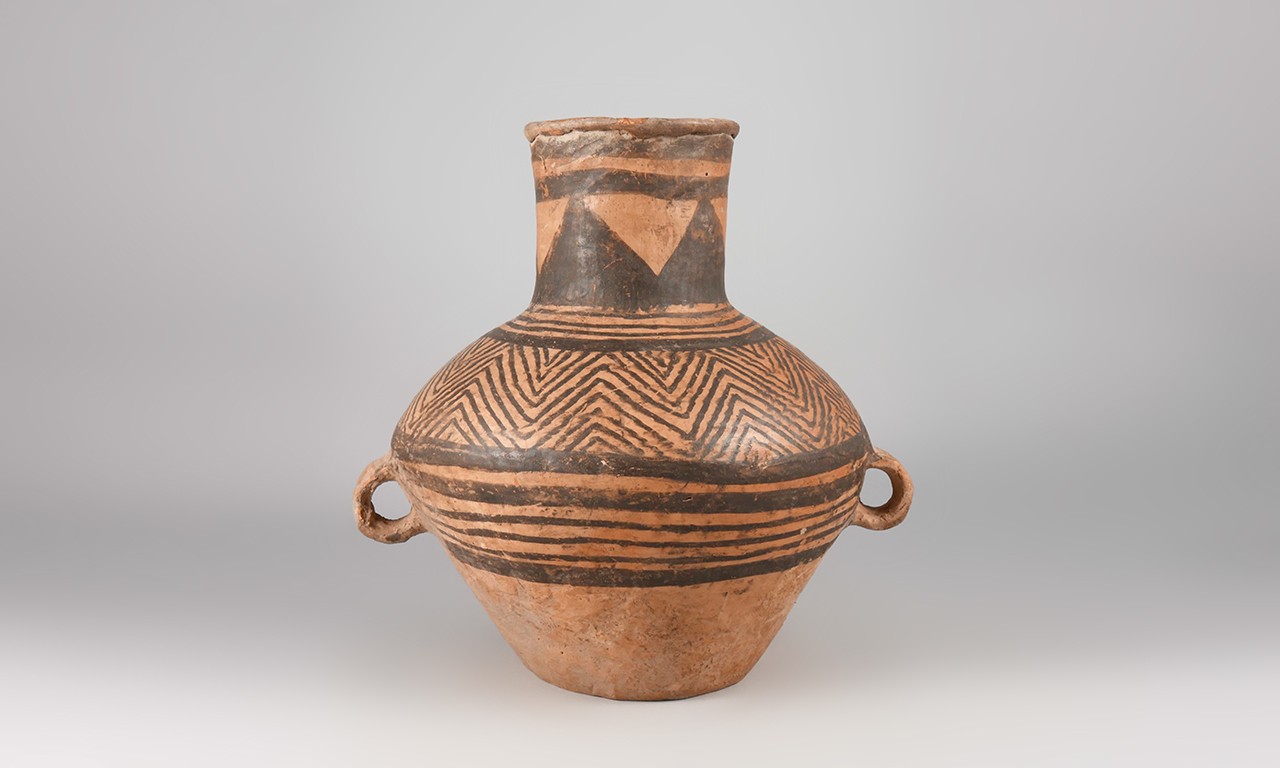 |
Jar, mid-Neolithic period (5000-3000 BCE)
Yangshao culture; Shaanxi or Henan Province, China
Painted ceramic; 9 x 7 1/2 in.
97.119.1
Gift of Mr. Lowell C. Martindale, Jr. |
Popular Motifs
The Bowers has yet another intricate jar in its collection. In contrast to the previous jar, this jar has a long neck but shares the lower handles. The zigzag pattern combined with horizontal lines on this jar were popular in Neolithic China. Leaving the lower body of the vessel blank was also a popular style, evidenced by the other vessels in this post that all have an unadorned lower section. The lower sections were likely left blank because the vessels sat in sunken pits in the ground, where decoration would not be appreciated. Because they may have been used for storage, the vessels’ placement in the ground encouraged stability and lessened the possibility for spillage of the contents.

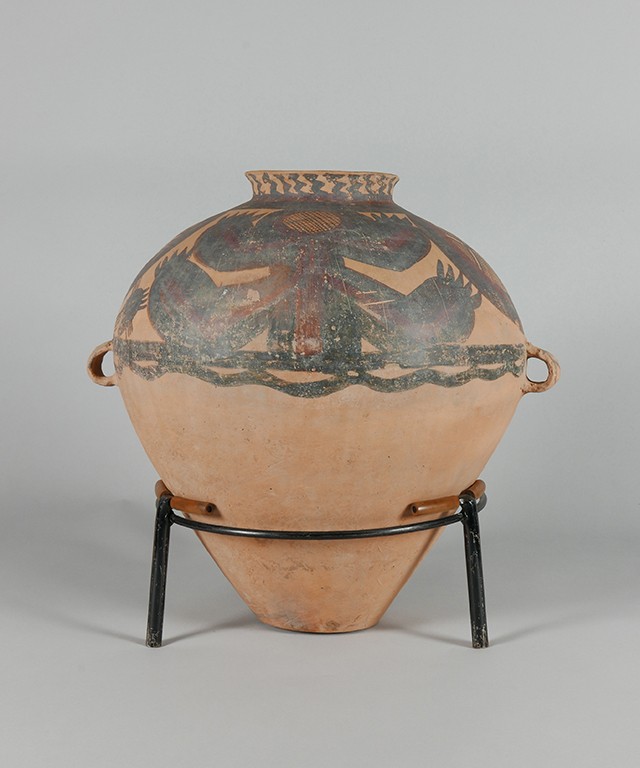 |
 |
Jar (Hu), Banshan phase, Neolithic period (2600-2300 BCE)
Majiayao culture; Gansu, Ningxia, or Qinghai Province, China
Painted ceramic; 19 x 18 in.
99.54.1
Gift of Linda Shih |
Jar (Guan), Machang phase, Neolithic period (2350-2050 BCE)
Majiayao culture; Gansu, Ningxia, or Qinghai Province, China
Painted ceramic; 16 5/16 x 40 in.
2000.39.1
Anonymous Gift |
Branching Apart
The Majiayao culture, a branch of the central Yangshao culture, existed in the modern-day Gansu, Ningxia, and Qinghai provinces. The above left vessel in the Bowers’ collection, an ornately decorated jar with a simple rounded silhouette, is from the Majiayao subculture. Majiayao pottery like this jar was commonly decorated with dark red or black pigmented ornamentation. Common patterns from the Majiayao subculture include smooth lines and circular or ovate patterns. Both of those are seen on this jar. Interestingly, there is also an anthropomorphic figure on the upper body of the jar. It has exaggerated ear-like forms stemming from a potential head with two possible arms bent at the elbows. This anthropomorphic perspective, however, is only one possible interpretation of the figure. Regardless of the interpretation, the distinctive figures are bordered by the characteristic ovate and linear patterns on the neck and center of the vessel, respectively.
Serving as a funerary vessel in the Neolithic period, this above right jar’s ornamentation is strikingly dramatic. The crosshatch design, which produces a net-like appearance, is common among vessels specifically from the Majiayao culture. Here the crosshatch occurs as a more open-weave design at the neck and more tightly within the “hatched-gourd” symbol that repeats around the body. The “hatched-gourd” symbol is one of the 140 common motifs of Chinese ceramics during this era.
In this piece, the gourd motif on the side of the vessel bears resemblance to the vessel itself. Another eye-catching design element is the toothed border that is found along the perimeter of the gourd designs and that circumvents the neck; this border accentuates the overall composition by virtue of being a contrasting shape and color.
These five vessels from the Chinese Neolithic era’s Yangshao culture all share two qualities: they are exquisite with fine detailing. Their delicate decoration is a testament to the dynamism of early Chinese artisanship.
This post was researched and written by Grace Funk, an intern for the Bowers Museum. Text and images may be under copyright. Please contact Collection Department for permission to use. References are available on request. Information subject to change upon further research.







Comments